Finance for Strategic Managers
VerifiedAdded on 2023/04/21
|13
|3482
|324
AI Summary
Contribute Materials
Your contribution can guide someone’s learning journey. Share your
documents today.
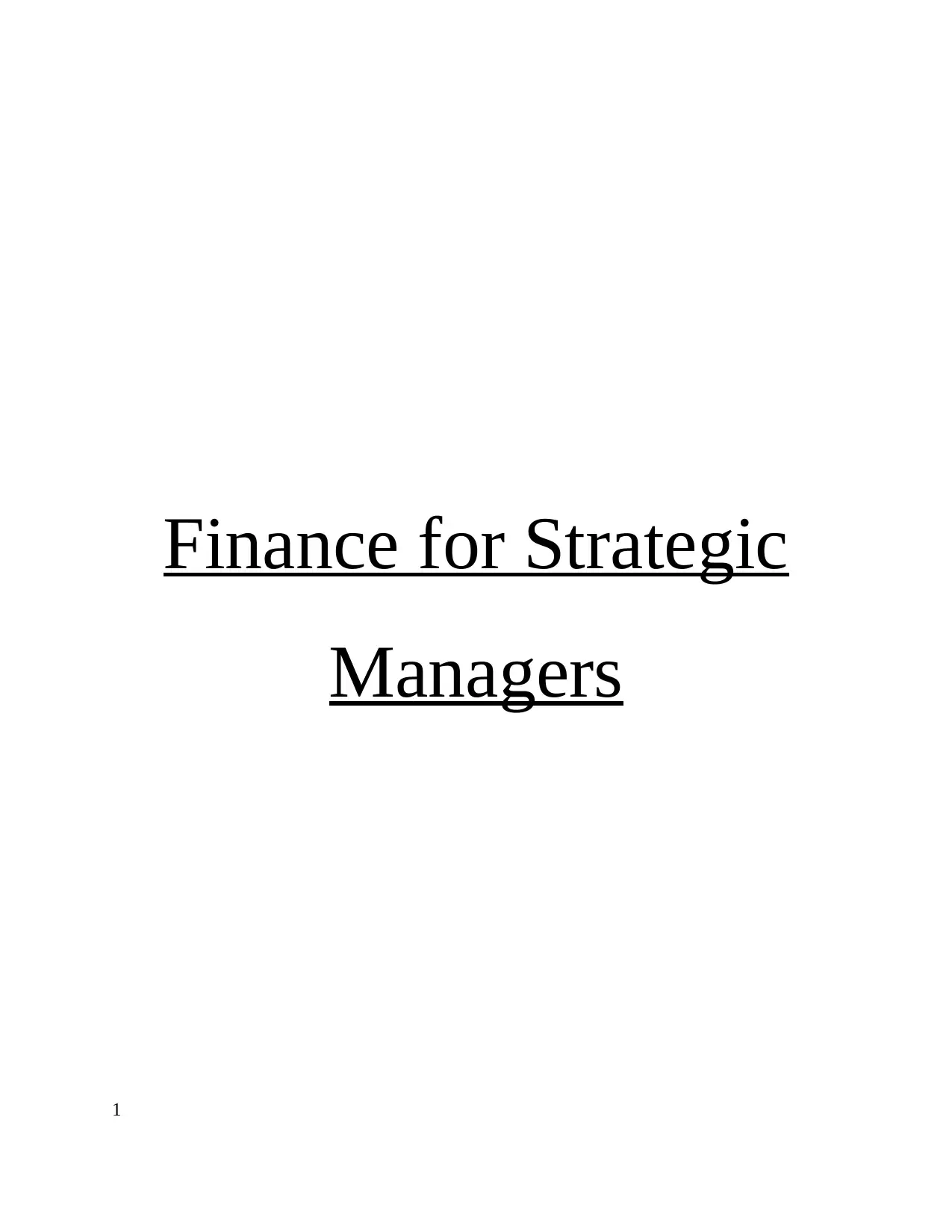
Finance for Strategic
Managers
1
Managers
1
Secure Best Marks with AI Grader
Need help grading? Try our AI Grader for instant feedback on your assignments.
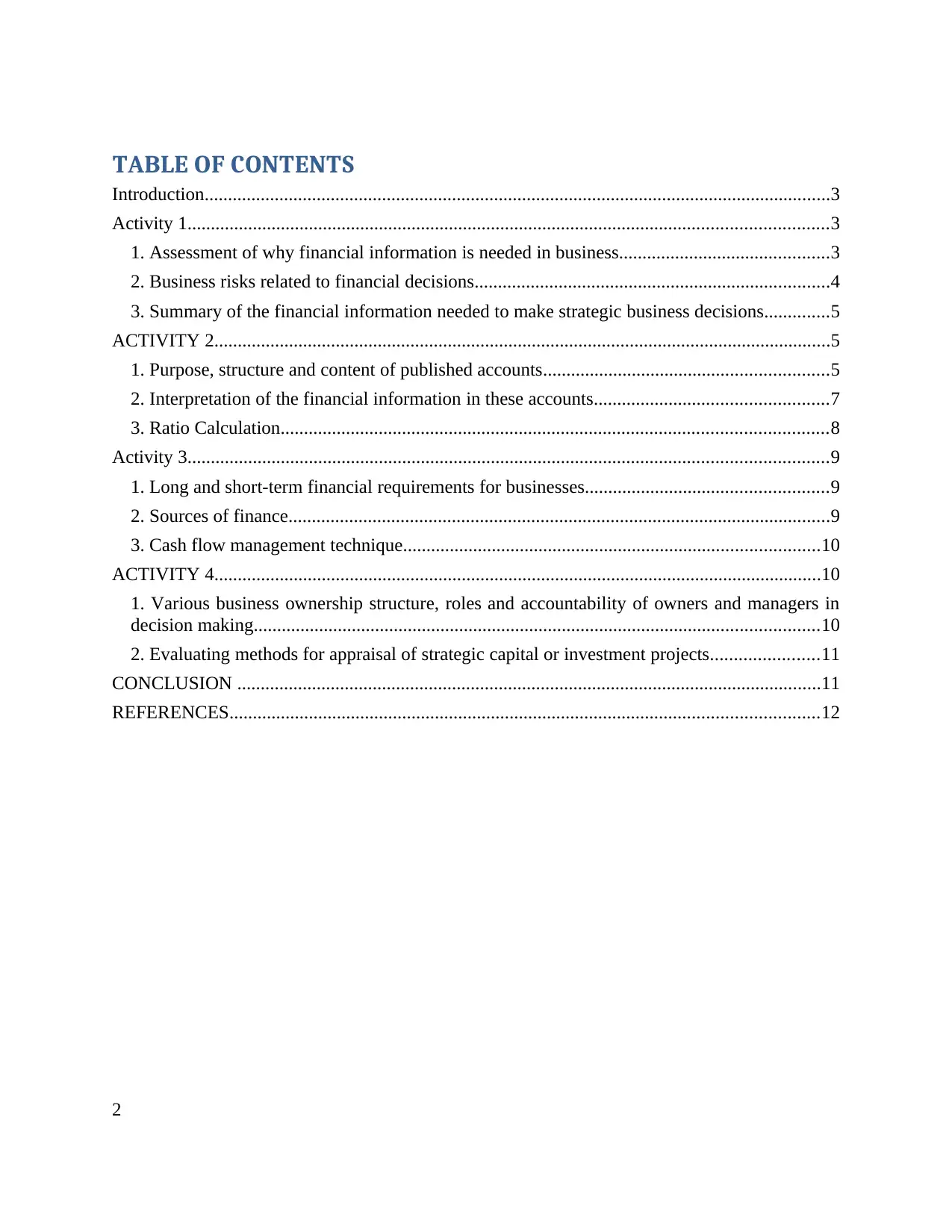
TABLE OF CONTENTS
Introduction......................................................................................................................................3
Activity 1.........................................................................................................................................3
1. Assessment of why financial information is needed in business.............................................3
2. Business risks related to financial decisions............................................................................4
3. Summary of the financial information needed to make strategic business decisions..............5
ACTIVITY 2....................................................................................................................................5
1. Purpose, structure and content of published accounts.............................................................5
2. Interpretation of the financial information in these accounts..................................................7
3. Ratio Calculation.....................................................................................................................8
Activity 3.........................................................................................................................................9
1. Long and short-term financial requirements for businesses....................................................9
2. Sources of finance....................................................................................................................9
3. Cash flow management technique.........................................................................................10
ACTIVITY 4..................................................................................................................................10
1. Various business ownership structure, roles and accountability of owners and managers in
decision making.........................................................................................................................10
2. Evaluating methods for appraisal of strategic capital or investment projects.......................11
CONCLUSION .............................................................................................................................11
REFERENCES..............................................................................................................................12
2
Introduction......................................................................................................................................3
Activity 1.........................................................................................................................................3
1. Assessment of why financial information is needed in business.............................................3
2. Business risks related to financial decisions............................................................................4
3. Summary of the financial information needed to make strategic business decisions..............5
ACTIVITY 2....................................................................................................................................5
1. Purpose, structure and content of published accounts.............................................................5
2. Interpretation of the financial information in these accounts..................................................7
3. Ratio Calculation.....................................................................................................................8
Activity 3.........................................................................................................................................9
1. Long and short-term financial requirements for businesses....................................................9
2. Sources of finance....................................................................................................................9
3. Cash flow management technique.........................................................................................10
ACTIVITY 4..................................................................................................................................10
1. Various business ownership structure, roles and accountability of owners and managers in
decision making.........................................................................................................................10
2. Evaluating methods for appraisal of strategic capital or investment projects.......................11
CONCLUSION .............................................................................................................................11
REFERENCES..............................................................................................................................12
2
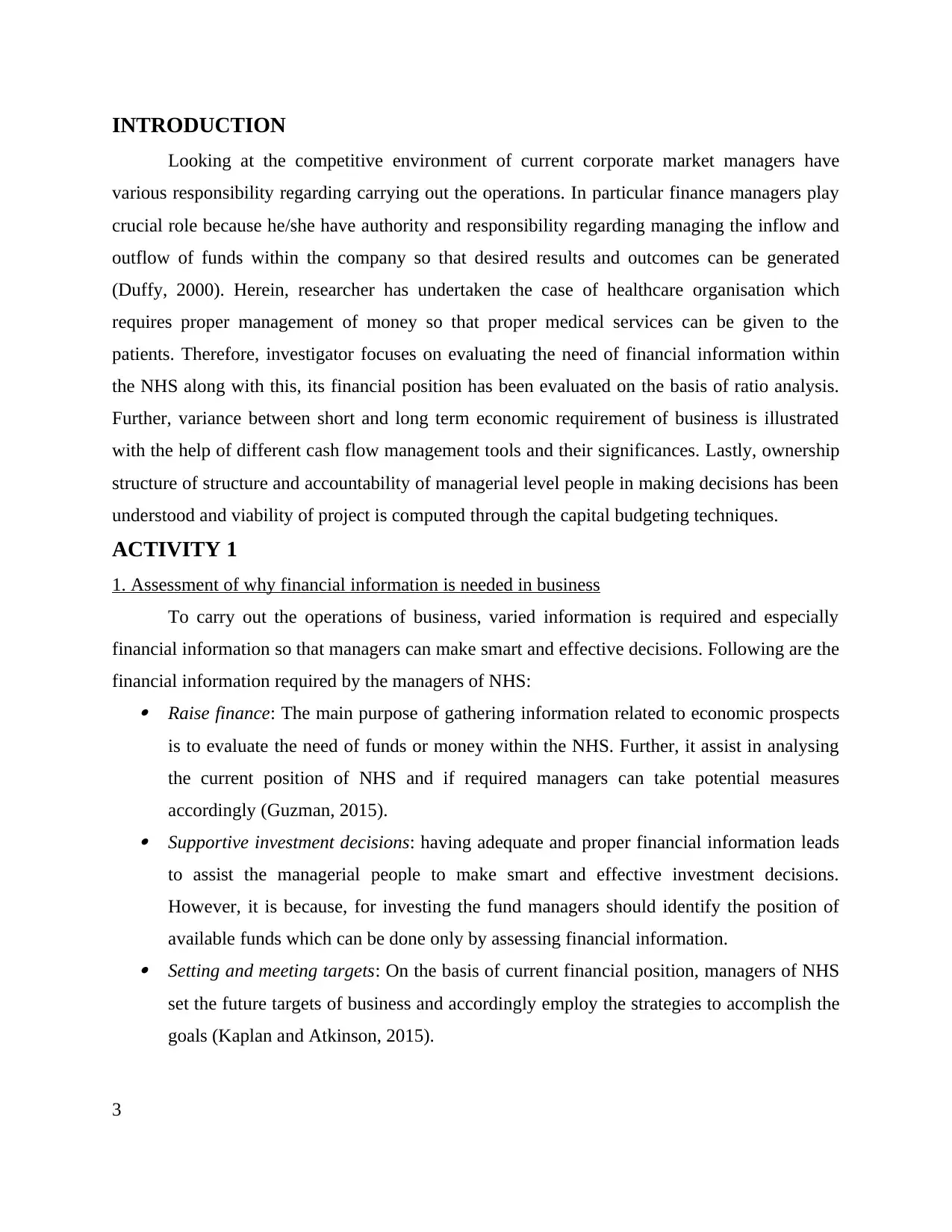
INTRODUCTION
Looking at the competitive environment of current corporate market managers have
various responsibility regarding carrying out the operations. In particular finance managers play
crucial role because he/she have authority and responsibility regarding managing the inflow and
outflow of funds within the company so that desired results and outcomes can be generated
(Duffy, 2000). Herein, researcher has undertaken the case of healthcare organisation which
requires proper management of money so that proper medical services can be given to the
patients. Therefore, investigator focuses on evaluating the need of financial information within
the NHS along with this, its financial position has been evaluated on the basis of ratio analysis.
Further, variance between short and long term economic requirement of business is illustrated
with the help of different cash flow management tools and their significances. Lastly, ownership
structure of structure and accountability of managerial level people in making decisions has been
understood and viability of project is computed through the capital budgeting techniques.
ACTIVITY 1
1. Assessment of why financial information is needed in business
To carry out the operations of business, varied information is required and especially
financial information so that managers can make smart and effective decisions. Following are the
financial information required by the managers of NHS: Raise finance: The main purpose of gathering information related to economic prospects
is to evaluate the need of funds or money within the NHS. Further, it assist in analysing
the current position of NHS and if required managers can take potential measures
accordingly (Guzman, 2015). Supportive investment decisions: having adequate and proper financial information leads
to assist the managerial people to make smart and effective investment decisions.
However, it is because, for investing the fund managers should identify the position of
available funds which can be done only by assessing financial information. Setting and meeting targets: On the basis of current financial position, managers of NHS
set the future targets of business and accordingly employ the strategies to accomplish the
goals (Kaplan and Atkinson, 2015).
3
Looking at the competitive environment of current corporate market managers have
various responsibility regarding carrying out the operations. In particular finance managers play
crucial role because he/she have authority and responsibility regarding managing the inflow and
outflow of funds within the company so that desired results and outcomes can be generated
(Duffy, 2000). Herein, researcher has undertaken the case of healthcare organisation which
requires proper management of money so that proper medical services can be given to the
patients. Therefore, investigator focuses on evaluating the need of financial information within
the NHS along with this, its financial position has been evaluated on the basis of ratio analysis.
Further, variance between short and long term economic requirement of business is illustrated
with the help of different cash flow management tools and their significances. Lastly, ownership
structure of structure and accountability of managerial level people in making decisions has been
understood and viability of project is computed through the capital budgeting techniques.
ACTIVITY 1
1. Assessment of why financial information is needed in business
To carry out the operations of business, varied information is required and especially
financial information so that managers can make smart and effective decisions. Following are the
financial information required by the managers of NHS: Raise finance: The main purpose of gathering information related to economic prospects
is to evaluate the need of funds or money within the NHS. Further, it assist in analysing
the current position of NHS and if required managers can take potential measures
accordingly (Guzman, 2015). Supportive investment decisions: having adequate and proper financial information leads
to assist the managerial people to make smart and effective investment decisions.
However, it is because, for investing the fund managers should identify the position of
available funds which can be done only by assessing financial information. Setting and meeting targets: On the basis of current financial position, managers of NHS
set the future targets of business and accordingly employ the strategies to accomplish the
goals (Kaplan and Atkinson, 2015).
3
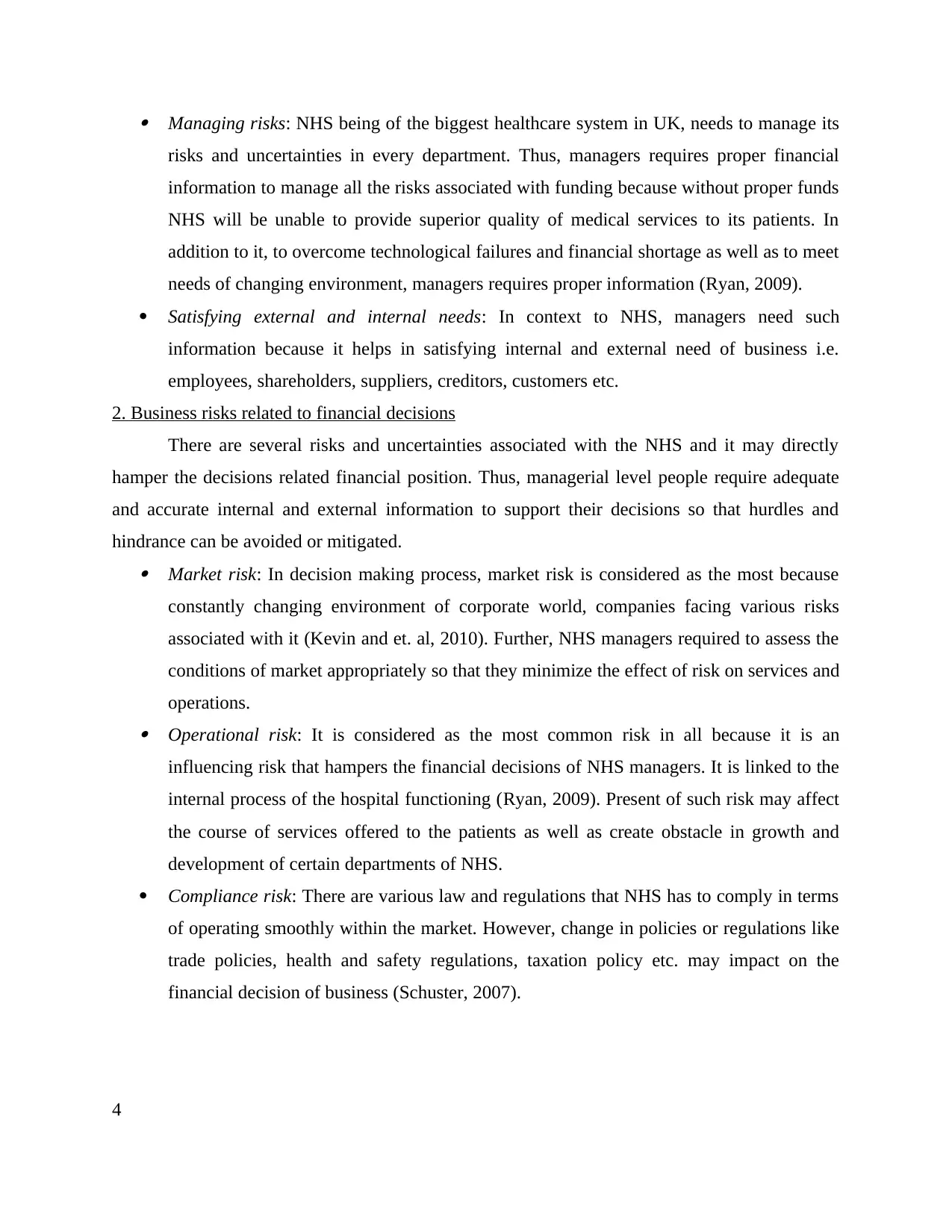
Managing risks: NHS being of the biggest healthcare system in UK, needs to manage its
risks and uncertainties in every department. Thus, managers requires proper financial
information to manage all the risks associated with funding because without proper funds
NHS will be unable to provide superior quality of medical services to its patients. In
addition to it, to overcome technological failures and financial shortage as well as to meet
needs of changing environment, managers requires proper information (Ryan, 2009).
Satisfying external and internal needs: In context to NHS, managers need such
information because it helps in satisfying internal and external need of business i.e.
employees, shareholders, suppliers, creditors, customers etc.
2. Business risks related to financial decisions
There are several risks and uncertainties associated with the NHS and it may directly
hamper the decisions related financial position. Thus, managerial level people require adequate
and accurate internal and external information to support their decisions so that hurdles and
hindrance can be avoided or mitigated. Market risk: In decision making process, market risk is considered as the most because
constantly changing environment of corporate world, companies facing various risks
associated with it (Kevin and et. al, 2010). Further, NHS managers required to assess the
conditions of market appropriately so that they minimize the effect of risk on services and
operations. Operational risk: It is considered as the most common risk in all because it is an
influencing risk that hampers the financial decisions of NHS managers. It is linked to the
internal process of the hospital functioning (Ryan, 2009). Present of such risk may affect
the course of services offered to the patients as well as create obstacle in growth and
development of certain departments of NHS.
Compliance risk: There are various law and regulations that NHS has to comply in terms
of operating smoothly within the market. However, change in policies or regulations like
trade policies, health and safety regulations, taxation policy etc. may impact on the
financial decision of business (Schuster, 2007).
4
risks and uncertainties in every department. Thus, managers requires proper financial
information to manage all the risks associated with funding because without proper funds
NHS will be unable to provide superior quality of medical services to its patients. In
addition to it, to overcome technological failures and financial shortage as well as to meet
needs of changing environment, managers requires proper information (Ryan, 2009).
Satisfying external and internal needs: In context to NHS, managers need such
information because it helps in satisfying internal and external need of business i.e.
employees, shareholders, suppliers, creditors, customers etc.
2. Business risks related to financial decisions
There are several risks and uncertainties associated with the NHS and it may directly
hamper the decisions related financial position. Thus, managerial level people require adequate
and accurate internal and external information to support their decisions so that hurdles and
hindrance can be avoided or mitigated. Market risk: In decision making process, market risk is considered as the most because
constantly changing environment of corporate world, companies facing various risks
associated with it (Kevin and et. al, 2010). Further, NHS managers required to assess the
conditions of market appropriately so that they minimize the effect of risk on services and
operations. Operational risk: It is considered as the most common risk in all because it is an
influencing risk that hampers the financial decisions of NHS managers. It is linked to the
internal process of the hospital functioning (Ryan, 2009). Present of such risk may affect
the course of services offered to the patients as well as create obstacle in growth and
development of certain departments of NHS.
Compliance risk: There are various law and regulations that NHS has to comply in terms
of operating smoothly within the market. However, change in policies or regulations like
trade policies, health and safety regulations, taxation policy etc. may impact on the
financial decision of business (Schuster, 2007).
4
Secure Best Marks with AI Grader
Need help grading? Try our AI Grader for instant feedback on your assignments.
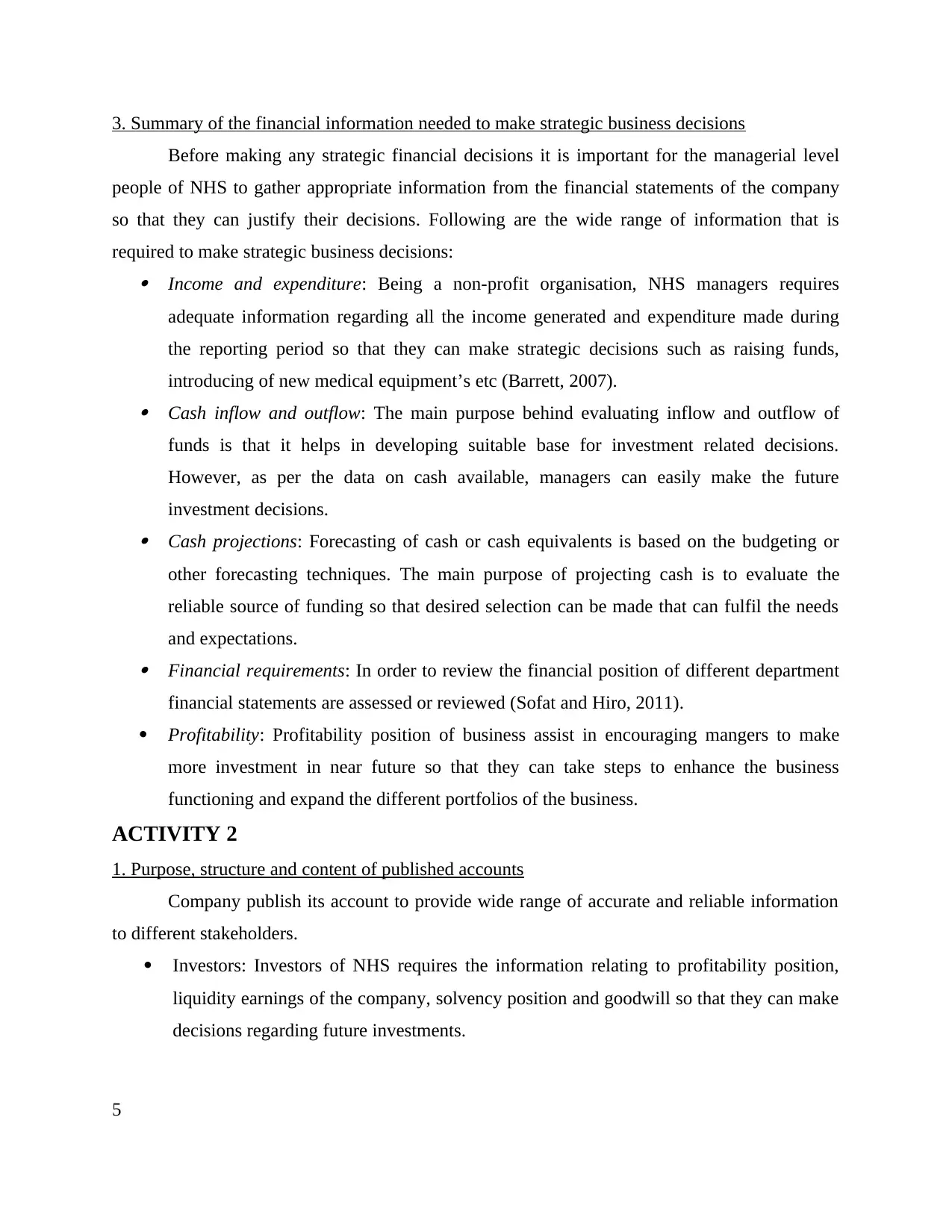
3. Summary of the financial information needed to make strategic business decisions
Before making any strategic financial decisions it is important for the managerial level
people of NHS to gather appropriate information from the financial statements of the company
so that they can justify their decisions. Following are the wide range of information that is
required to make strategic business decisions: Income and expenditure: Being a non-profit organisation, NHS managers requires
adequate information regarding all the income generated and expenditure made during
the reporting period so that they can make strategic decisions such as raising funds,
introducing of new medical equipment’s etc (Barrett, 2007). Cash inflow and outflow: The main purpose behind evaluating inflow and outflow of
funds is that it helps in developing suitable base for investment related decisions.
However, as per the data on cash available, managers can easily make the future
investment decisions. Cash projections: Forecasting of cash or cash equivalents is based on the budgeting or
other forecasting techniques. The main purpose of projecting cash is to evaluate the
reliable source of funding so that desired selection can be made that can fulfil the needs
and expectations. Financial requirements: In order to review the financial position of different department
financial statements are assessed or reviewed (Sofat and Hiro, 2011).
Profitability: Profitability position of business assist in encouraging mangers to make
more investment in near future so that they can take steps to enhance the business
functioning and expand the different portfolios of the business.
ACTIVITY 2
1. Purpose, structure and content of published accounts
Company publish its account to provide wide range of accurate and reliable information
to different stakeholders.
Investors: Investors of NHS requires the information relating to profitability position,
liquidity earnings of the company, solvency position and goodwill so that they can make
decisions regarding future investments.
5
Before making any strategic financial decisions it is important for the managerial level
people of NHS to gather appropriate information from the financial statements of the company
so that they can justify their decisions. Following are the wide range of information that is
required to make strategic business decisions: Income and expenditure: Being a non-profit organisation, NHS managers requires
adequate information regarding all the income generated and expenditure made during
the reporting period so that they can make strategic decisions such as raising funds,
introducing of new medical equipment’s etc (Barrett, 2007). Cash inflow and outflow: The main purpose behind evaluating inflow and outflow of
funds is that it helps in developing suitable base for investment related decisions.
However, as per the data on cash available, managers can easily make the future
investment decisions. Cash projections: Forecasting of cash or cash equivalents is based on the budgeting or
other forecasting techniques. The main purpose of projecting cash is to evaluate the
reliable source of funding so that desired selection can be made that can fulfil the needs
and expectations. Financial requirements: In order to review the financial position of different department
financial statements are assessed or reviewed (Sofat and Hiro, 2011).
Profitability: Profitability position of business assist in encouraging mangers to make
more investment in near future so that they can take steps to enhance the business
functioning and expand the different portfolios of the business.
ACTIVITY 2
1. Purpose, structure and content of published accounts
Company publish its account to provide wide range of accurate and reliable information
to different stakeholders.
Investors: Investors of NHS requires the information relating to profitability position,
liquidity earnings of the company, solvency position and goodwill so that they can make
decisions regarding future investments.
5
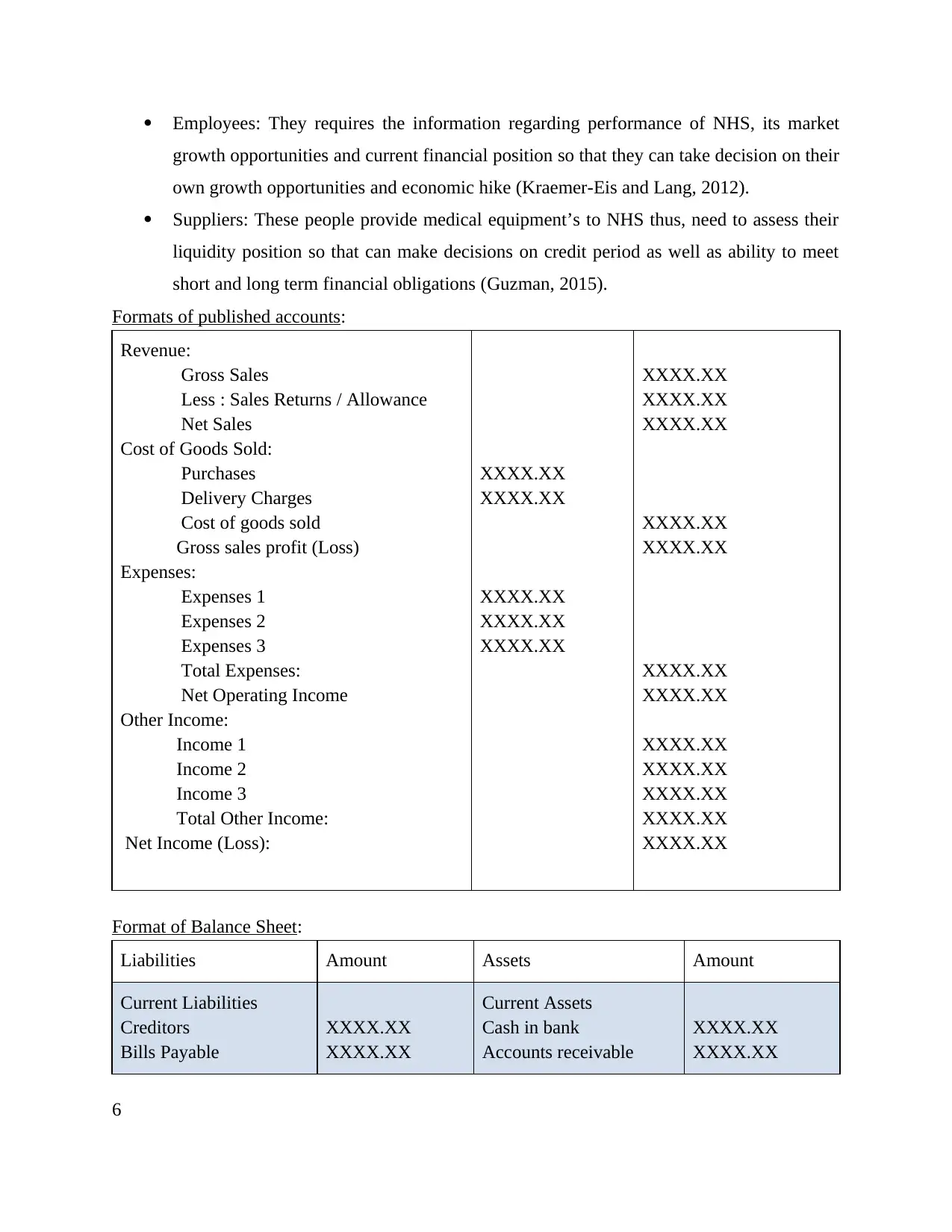
Employees: They requires the information regarding performance of NHS, its market
growth opportunities and current financial position so that they can take decision on their
own growth opportunities and economic hike (Kraemer-Eis and Lang, 2012).
Suppliers: These people provide medical equipment’s to NHS thus, need to assess their
liquidity position so that can make decisions on credit period as well as ability to meet
short and long term financial obligations (Guzman, 2015).
Formats of published accounts:
Revenue:
Gross Sales
Less : Sales Returns / Allowance
Net Sales
Cost of Goods Sold:
Purchases
Delivery Charges
Cost of goods sold
Gross sales profit (Loss)
Expenses:
Expenses 1
Expenses 2
Expenses 3
Total Expenses:
Net Operating Income
Other Income:
Income 1
Income 2
Income 3
Total Other Income:
Net Income (Loss):
XXXX.XX
XXXX.XX
XXXX.XX
XXXX.XX
XXXX.XX
XXXX.XX
XXXX.XX
XXXX.XX
XXXX.XX
XXXX.XX
XXXX.XX
XXXX.XX
XXXX.XX
XXXX.XX
XXXX.XX
XXXX.XX
XXXX.XX
Format of Balance Sheet:
Liabilities Amount Assets Amount
Current Liabilities
Creditors
Bills Payable
XXXX.XX
XXXX.XX
Current Assets
Cash in bank
Accounts receivable
XXXX.XX
XXXX.XX
6
growth opportunities and current financial position so that they can take decision on their
own growth opportunities and economic hike (Kraemer-Eis and Lang, 2012).
Suppliers: These people provide medical equipment’s to NHS thus, need to assess their
liquidity position so that can make decisions on credit period as well as ability to meet
short and long term financial obligations (Guzman, 2015).
Formats of published accounts:
Revenue:
Gross Sales
Less : Sales Returns / Allowance
Net Sales
Cost of Goods Sold:
Purchases
Delivery Charges
Cost of goods sold
Gross sales profit (Loss)
Expenses:
Expenses 1
Expenses 2
Expenses 3
Total Expenses:
Net Operating Income
Other Income:
Income 1
Income 2
Income 3
Total Other Income:
Net Income (Loss):
XXXX.XX
XXXX.XX
XXXX.XX
XXXX.XX
XXXX.XX
XXXX.XX
XXXX.XX
XXXX.XX
XXXX.XX
XXXX.XX
XXXX.XX
XXXX.XX
XXXX.XX
XXXX.XX
XXXX.XX
XXXX.XX
XXXX.XX
Format of Balance Sheet:
Liabilities Amount Assets Amount
Current Liabilities
Creditors
Bills Payable
XXXX.XX
XXXX.XX
Current Assets
Cash in bank
Accounts receivable
XXXX.XX
XXXX.XX
6
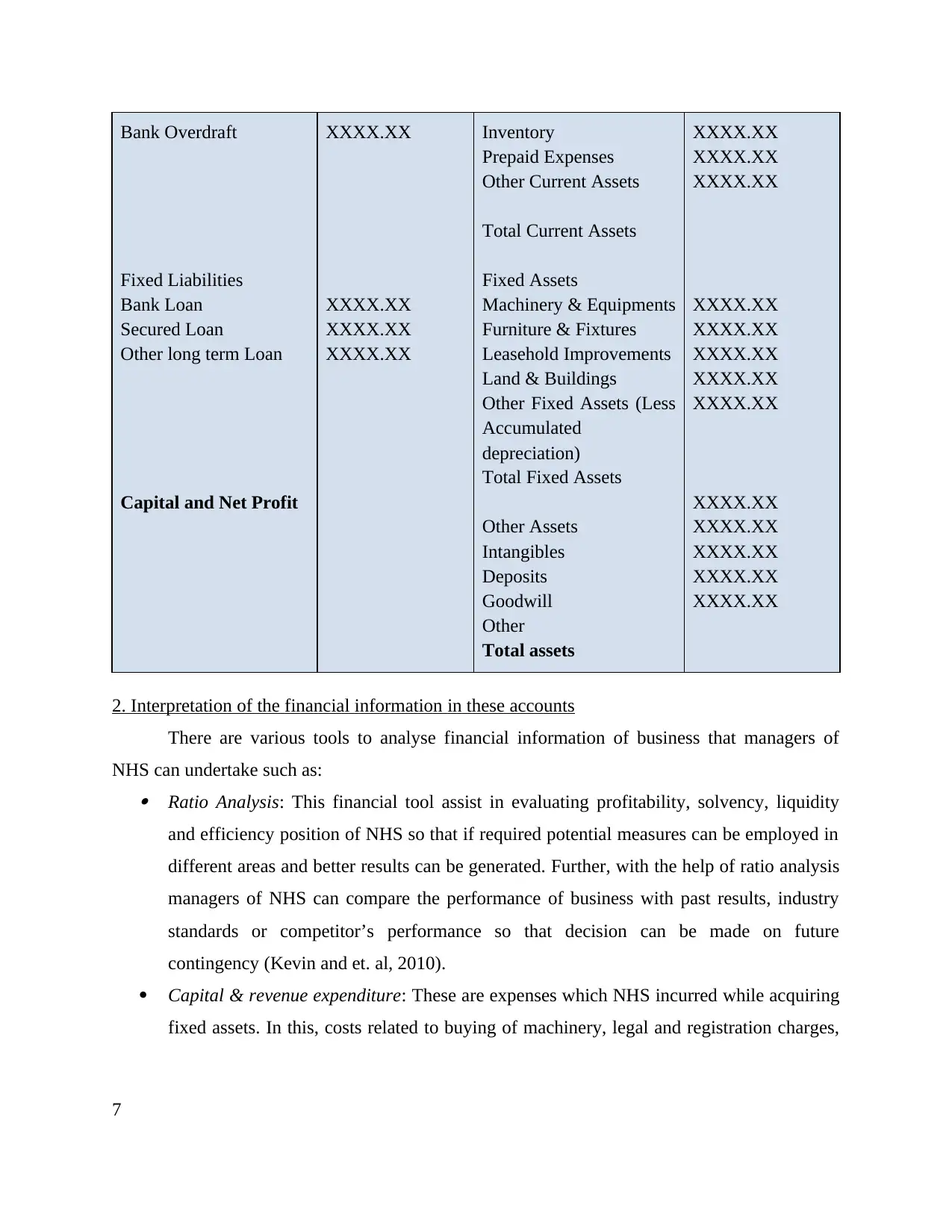
Bank Overdraft
Fixed Liabilities
Bank Loan
Secured Loan
Other long term Loan
Capital and Net Profit
XXXX.XX
XXXX.XX
XXXX.XX
XXXX.XX
Inventory
Prepaid Expenses
Other Current Assets
Total Current Assets
Fixed Assets
Machinery & Equipments
Furniture & Fixtures
Leasehold Improvements
Land & Buildings
Other Fixed Assets (Less
Accumulated
depreciation)
Total Fixed Assets
Other Assets
Intangibles
Deposits
Goodwill
Other
Total assets
XXXX.XX
XXXX.XX
XXXX.XX
XXXX.XX
XXXX.XX
XXXX.XX
XXXX.XX
XXXX.XX
XXXX.XX
XXXX.XX
XXXX.XX
XXXX.XX
XXXX.XX
2. Interpretation of the financial information in these accounts
There are various tools to analyse financial information of business that managers of
NHS can undertake such as: Ratio Analysis: This financial tool assist in evaluating profitability, solvency, liquidity
and efficiency position of NHS so that if required potential measures can be employed in
different areas and better results can be generated. Further, with the help of ratio analysis
managers of NHS can compare the performance of business with past results, industry
standards or competitor’s performance so that decision can be made on future
contingency (Kevin and et. al, 2010).
Capital & revenue expenditure: These are expenses which NHS incurred while acquiring
fixed assets. In this, costs related to buying of machinery, legal and registration charges,
7
Fixed Liabilities
Bank Loan
Secured Loan
Other long term Loan
Capital and Net Profit
XXXX.XX
XXXX.XX
XXXX.XX
XXXX.XX
Inventory
Prepaid Expenses
Other Current Assets
Total Current Assets
Fixed Assets
Machinery & Equipments
Furniture & Fixtures
Leasehold Improvements
Land & Buildings
Other Fixed Assets (Less
Accumulated
depreciation)
Total Fixed Assets
Other Assets
Intangibles
Deposits
Goodwill
Other
Total assets
XXXX.XX
XXXX.XX
XXXX.XX
XXXX.XX
XXXX.XX
XXXX.XX
XXXX.XX
XXXX.XX
XXXX.XX
XXXX.XX
XXXX.XX
XXXX.XX
XXXX.XX
2. Interpretation of the financial information in these accounts
There are various tools to analyse financial information of business that managers of
NHS can undertake such as: Ratio Analysis: This financial tool assist in evaluating profitability, solvency, liquidity
and efficiency position of NHS so that if required potential measures can be employed in
different areas and better results can be generated. Further, with the help of ratio analysis
managers of NHS can compare the performance of business with past results, industry
standards or competitor’s performance so that decision can be made on future
contingency (Kevin and et. al, 2010).
Capital & revenue expenditure: These are expenses which NHS incurred while acquiring
fixed assets. In this, costs related to buying of machinery, legal and registration charges,
7
Paraphrase This Document
Need a fresh take? Get an instant paraphrase of this document with our AI Paraphraser
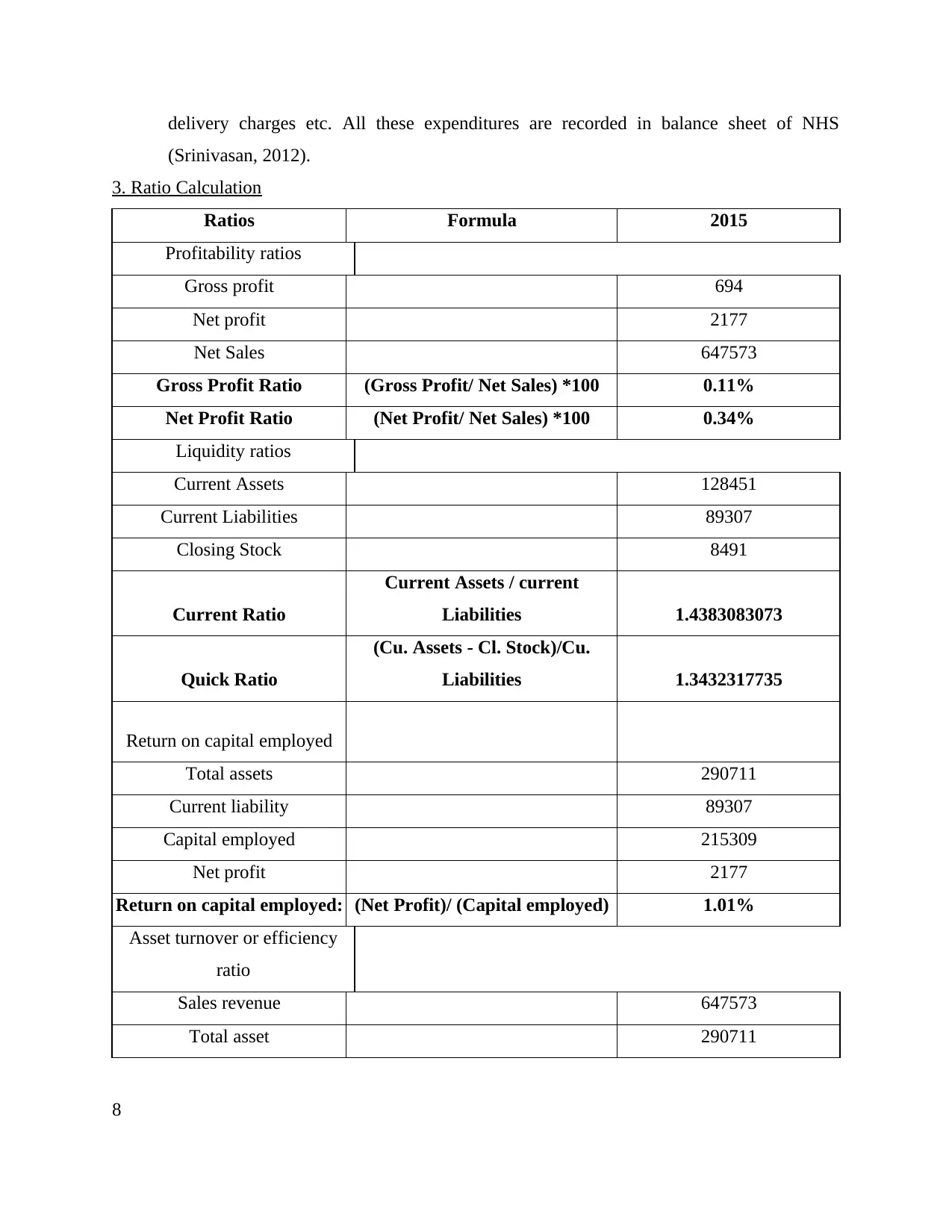
delivery charges etc. All these expenditures are recorded in balance sheet of NHS
(Srinivasan, 2012).
3. Ratio Calculation
Ratios Formula 2015
Profitability ratios
Gross profit 694
Net profit 2177
Net Sales 647573
Gross Profit Ratio (Gross Profit/ Net Sales) *100 0.11%
Net Profit Ratio (Net Profit/ Net Sales) *100 0.34%
Liquidity ratios
Current Assets 128451
Current Liabilities 89307
Closing Stock 8491
Current Ratio
Current Assets / current
Liabilities 1.4383083073
Quick Ratio
(Cu. Assets - Cl. Stock)/Cu.
Liabilities 1.3432317735
Return on capital employed
Total assets 290711
Current liability 89307
Capital employed 215309
Net profit 2177
Return on capital employed: (Net Profit)/ (Capital employed) 1.01%
Asset turnover or efficiency
ratio
Sales revenue 647573
Total asset 290711
8
(Srinivasan, 2012).
3. Ratio Calculation
Ratios Formula 2015
Profitability ratios
Gross profit 694
Net profit 2177
Net Sales 647573
Gross Profit Ratio (Gross Profit/ Net Sales) *100 0.11%
Net Profit Ratio (Net Profit/ Net Sales) *100 0.34%
Liquidity ratios
Current Assets 128451
Current Liabilities 89307
Closing Stock 8491
Current Ratio
Current Assets / current
Liabilities 1.4383083073
Quick Ratio
(Cu. Assets - Cl. Stock)/Cu.
Liabilities 1.3432317735
Return on capital employed
Total assets 290711
Current liability 89307
Capital employed 215309
Net profit 2177
Return on capital employed: (Net Profit)/ (Capital employed) 1.01%
Asset turnover or efficiency
ratio
Sales revenue 647573
Total asset 290711
8
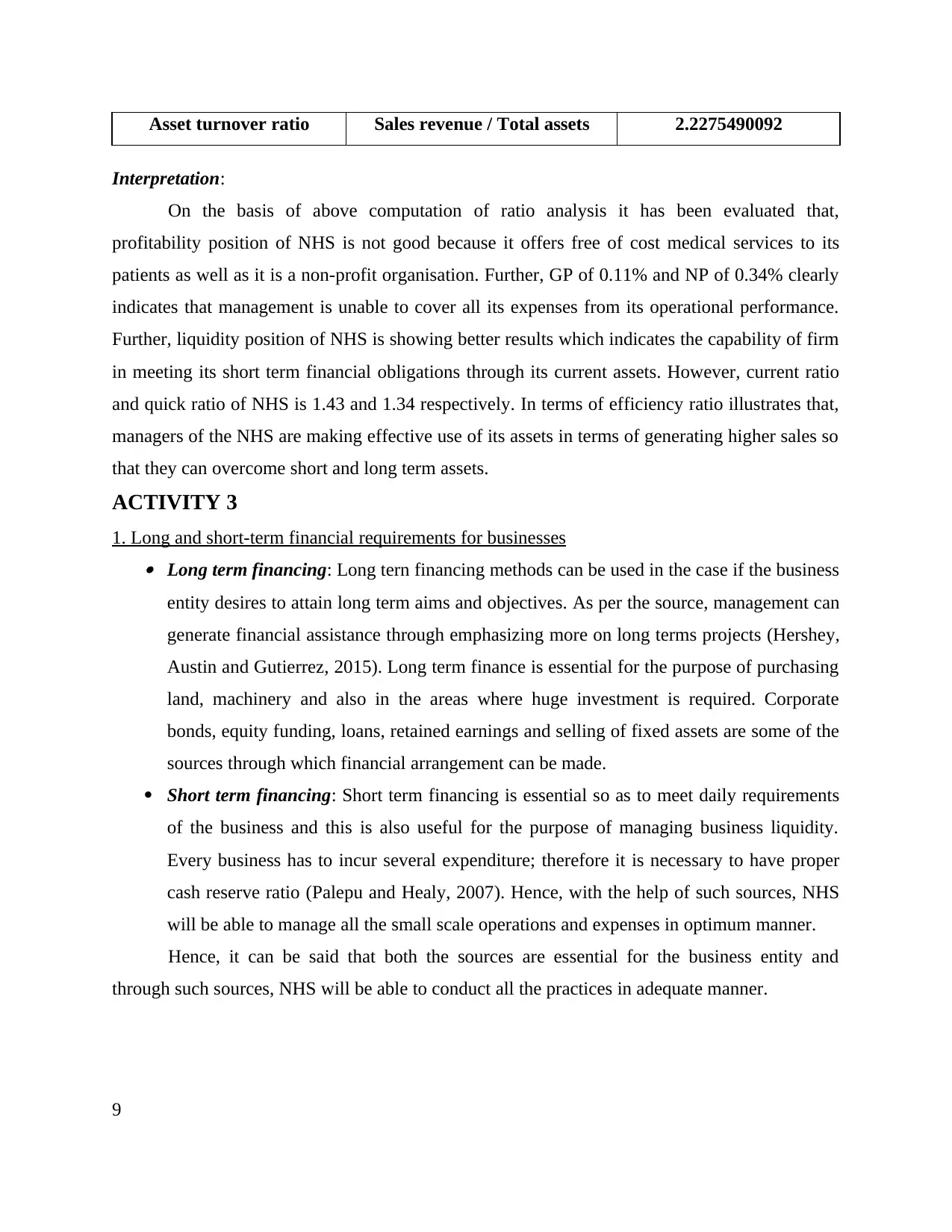
Asset turnover ratio Sales revenue / Total assets 2.2275490092
Interpretation:
On the basis of above computation of ratio analysis it has been evaluated that,
profitability position of NHS is not good because it offers free of cost medical services to its
patients as well as it is a non-profit organisation. Further, GP of 0.11% and NP of 0.34% clearly
indicates that management is unable to cover all its expenses from its operational performance.
Further, liquidity position of NHS is showing better results which indicates the capability of firm
in meeting its short term financial obligations through its current assets. However, current ratio
and quick ratio of NHS is 1.43 and 1.34 respectively. In terms of efficiency ratio illustrates that,
managers of the NHS are making effective use of its assets in terms of generating higher sales so
that they can overcome short and long term assets.
ACTIVITY 3
1. Long and short-term financial requirements for businesses Long term financing: Long tern financing methods can be used in the case if the business
entity desires to attain long term aims and objectives. As per the source, management can
generate financial assistance through emphasizing more on long terms projects (Hershey,
Austin and Gutierrez, 2015). Long term finance is essential for the purpose of purchasing
land, machinery and also in the areas where huge investment is required. Corporate
bonds, equity funding, loans, retained earnings and selling of fixed assets are some of the
sources through which financial arrangement can be made.
Short term financing: Short term financing is essential so as to meet daily requirements
of the business and this is also useful for the purpose of managing business liquidity.
Every business has to incur several expenditure; therefore it is necessary to have proper
cash reserve ratio (Palepu and Healy, 2007). Hence, with the help of such sources, NHS
will be able to manage all the small scale operations and expenses in optimum manner.
Hence, it can be said that both the sources are essential for the business entity and
through such sources, NHS will be able to conduct all the practices in adequate manner.
9
Interpretation:
On the basis of above computation of ratio analysis it has been evaluated that,
profitability position of NHS is not good because it offers free of cost medical services to its
patients as well as it is a non-profit organisation. Further, GP of 0.11% and NP of 0.34% clearly
indicates that management is unable to cover all its expenses from its operational performance.
Further, liquidity position of NHS is showing better results which indicates the capability of firm
in meeting its short term financial obligations through its current assets. However, current ratio
and quick ratio of NHS is 1.43 and 1.34 respectively. In terms of efficiency ratio illustrates that,
managers of the NHS are making effective use of its assets in terms of generating higher sales so
that they can overcome short and long term assets.
ACTIVITY 3
1. Long and short-term financial requirements for businesses Long term financing: Long tern financing methods can be used in the case if the business
entity desires to attain long term aims and objectives. As per the source, management can
generate financial assistance through emphasizing more on long terms projects (Hershey,
Austin and Gutierrez, 2015). Long term finance is essential for the purpose of purchasing
land, machinery and also in the areas where huge investment is required. Corporate
bonds, equity funding, loans, retained earnings and selling of fixed assets are some of the
sources through which financial arrangement can be made.
Short term financing: Short term financing is essential so as to meet daily requirements
of the business and this is also useful for the purpose of managing business liquidity.
Every business has to incur several expenditure; therefore it is necessary to have proper
cash reserve ratio (Palepu and Healy, 2007). Hence, with the help of such sources, NHS
will be able to manage all the small scale operations and expenses in optimum manner.
Hence, it can be said that both the sources are essential for the business entity and
through such sources, NHS will be able to conduct all the practices in adequate manner.
9
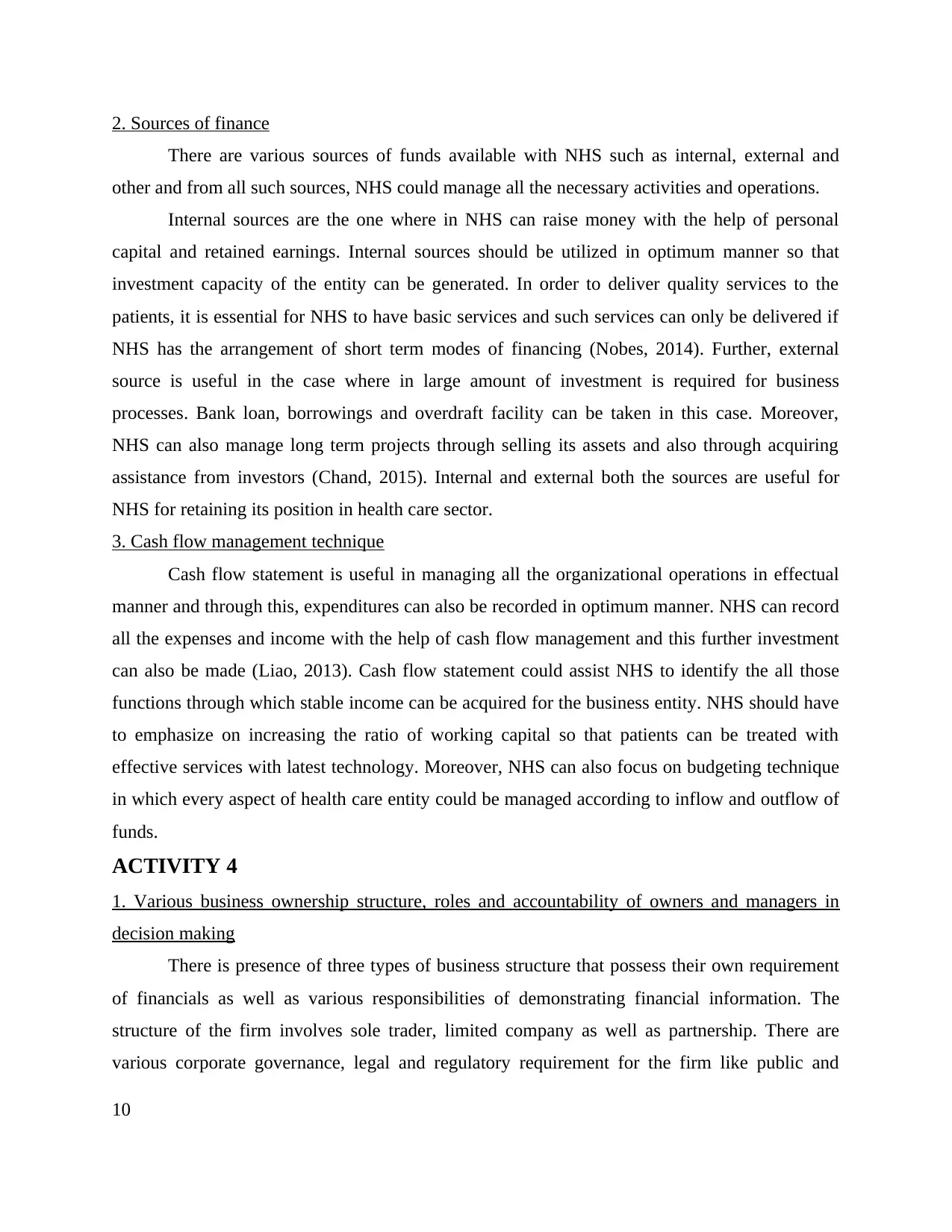
2. Sources of finance
There are various sources of funds available with NHS such as internal, external and
other and from all such sources, NHS could manage all the necessary activities and operations.
Internal sources are the one where in NHS can raise money with the help of personal
capital and retained earnings. Internal sources should be utilized in optimum manner so that
investment capacity of the entity can be generated. In order to deliver quality services to the
patients, it is essential for NHS to have basic services and such services can only be delivered if
NHS has the arrangement of short term modes of financing (Nobes, 2014). Further, external
source is useful in the case where in large amount of investment is required for business
processes. Bank loan, borrowings and overdraft facility can be taken in this case. Moreover,
NHS can also manage long term projects through selling its assets and also through acquiring
assistance from investors (Chand, 2015). Internal and external both the sources are useful for
NHS for retaining its position in health care sector.
3. Cash flow management technique
Cash flow statement is useful in managing all the organizational operations in effectual
manner and through this, expenditures can also be recorded in optimum manner. NHS can record
all the expenses and income with the help of cash flow management and this further investment
can also be made (Liao, 2013). Cash flow statement could assist NHS to identify the all those
functions through which stable income can be acquired for the business entity. NHS should have
to emphasize on increasing the ratio of working capital so that patients can be treated with
effective services with latest technology. Moreover, NHS can also focus on budgeting technique
in which every aspect of health care entity could be managed according to inflow and outflow of
funds.
ACTIVITY 4
1. Various business ownership structure, roles and accountability of owners and managers in
decision making
There is presence of three types of business structure that possess their own requirement
of financials as well as various responsibilities of demonstrating financial information. The
structure of the firm involves sole trader, limited company as well as partnership. There are
various corporate governance, legal and regulatory requirement for the firm like public and
10
There are various sources of funds available with NHS such as internal, external and
other and from all such sources, NHS could manage all the necessary activities and operations.
Internal sources are the one where in NHS can raise money with the help of personal
capital and retained earnings. Internal sources should be utilized in optimum manner so that
investment capacity of the entity can be generated. In order to deliver quality services to the
patients, it is essential for NHS to have basic services and such services can only be delivered if
NHS has the arrangement of short term modes of financing (Nobes, 2014). Further, external
source is useful in the case where in large amount of investment is required for business
processes. Bank loan, borrowings and overdraft facility can be taken in this case. Moreover,
NHS can also manage long term projects through selling its assets and also through acquiring
assistance from investors (Chand, 2015). Internal and external both the sources are useful for
NHS for retaining its position in health care sector.
3. Cash flow management technique
Cash flow statement is useful in managing all the organizational operations in effectual
manner and through this, expenditures can also be recorded in optimum manner. NHS can record
all the expenses and income with the help of cash flow management and this further investment
can also be made (Liao, 2013). Cash flow statement could assist NHS to identify the all those
functions through which stable income can be acquired for the business entity. NHS should have
to emphasize on increasing the ratio of working capital so that patients can be treated with
effective services with latest technology. Moreover, NHS can also focus on budgeting technique
in which every aspect of health care entity could be managed according to inflow and outflow of
funds.
ACTIVITY 4
1. Various business ownership structure, roles and accountability of owners and managers in
decision making
There is presence of three types of business structure that possess their own requirement
of financials as well as various responsibilities of demonstrating financial information. The
structure of the firm involves sole trader, limited company as well as partnership. There are
various corporate governance, legal and regulatory requirement for the firm like public and
10
Secure Best Marks with AI Grader
Need help grading? Try our AI Grader for instant feedback on your assignments.
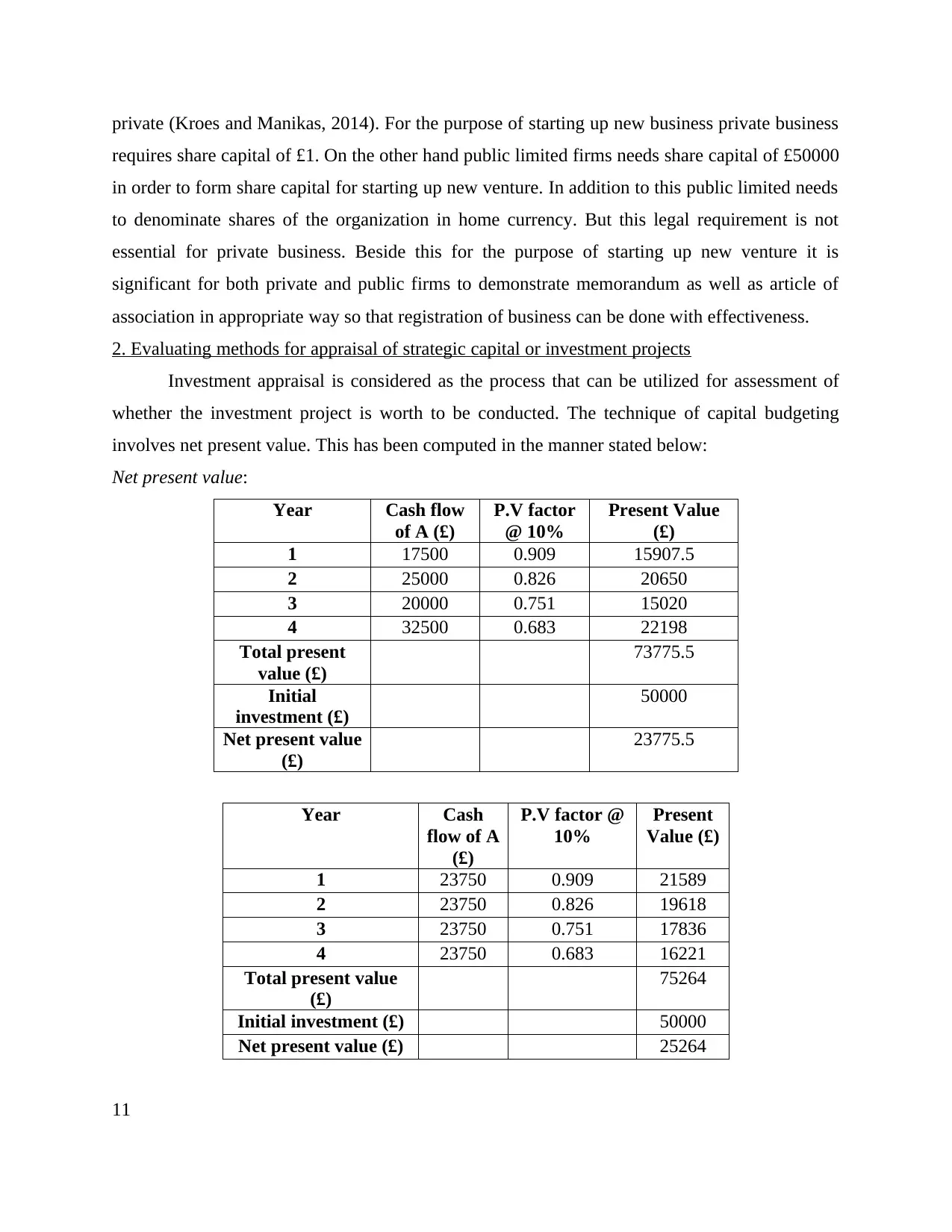
private (Kroes and Manikas, 2014). For the purpose of starting up new business private business
requires share capital of £1. On the other hand public limited firms needs share capital of £50000
in order to form share capital for starting up new venture. In addition to this public limited needs
to denominate shares of the organization in home currency. But this legal requirement is not
essential for private business. Beside this for the purpose of starting up new venture it is
significant for both private and public firms to demonstrate memorandum as well as article of
association in appropriate way so that registration of business can be done with effectiveness.
2. Evaluating methods for appraisal of strategic capital or investment projects
Investment appraisal is considered as the process that can be utilized for assessment of
whether the investment project is worth to be conducted. The technique of capital budgeting
involves net present value. This has been computed in the manner stated below:
Net present value:
Year Cash flow
of A (£)
P.V factor
@ 10%
Present Value
(£)
1 17500 0.909 15907.5
2 25000 0.826 20650
3 20000 0.751 15020
4 32500 0.683 22198
Total present
value (£)
73775.5
Initial
investment (£)
50000
Net present value
(£)
23775.5
Year Cash
flow of A
(£)
P.V factor @
10%
Present
Value (£)
1 23750 0.909 21589
2 23750 0.826 19618
3 23750 0.751 17836
4 23750 0.683 16221
Total present value
(£)
75264
Initial investment (£) 50000
Net present value (£) 25264
11
requires share capital of £1. On the other hand public limited firms needs share capital of £50000
in order to form share capital for starting up new venture. In addition to this public limited needs
to denominate shares of the organization in home currency. But this legal requirement is not
essential for private business. Beside this for the purpose of starting up new venture it is
significant for both private and public firms to demonstrate memorandum as well as article of
association in appropriate way so that registration of business can be done with effectiveness.
2. Evaluating methods for appraisal of strategic capital or investment projects
Investment appraisal is considered as the process that can be utilized for assessment of
whether the investment project is worth to be conducted. The technique of capital budgeting
involves net present value. This has been computed in the manner stated below:
Net present value:
Year Cash flow
of A (£)
P.V factor
@ 10%
Present Value
(£)
1 17500 0.909 15907.5
2 25000 0.826 20650
3 20000 0.751 15020
4 32500 0.683 22198
Total present
value (£)
73775.5
Initial
investment (£)
50000
Net present value
(£)
23775.5
Year Cash
flow of A
(£)
P.V factor @
10%
Present
Value (£)
1 23750 0.909 21589
2 23750 0.826 19618
3 23750 0.751 17836
4 23750 0.683 16221
Total present value
(£)
75264
Initial investment (£) 50000
Net present value (£) 25264
11
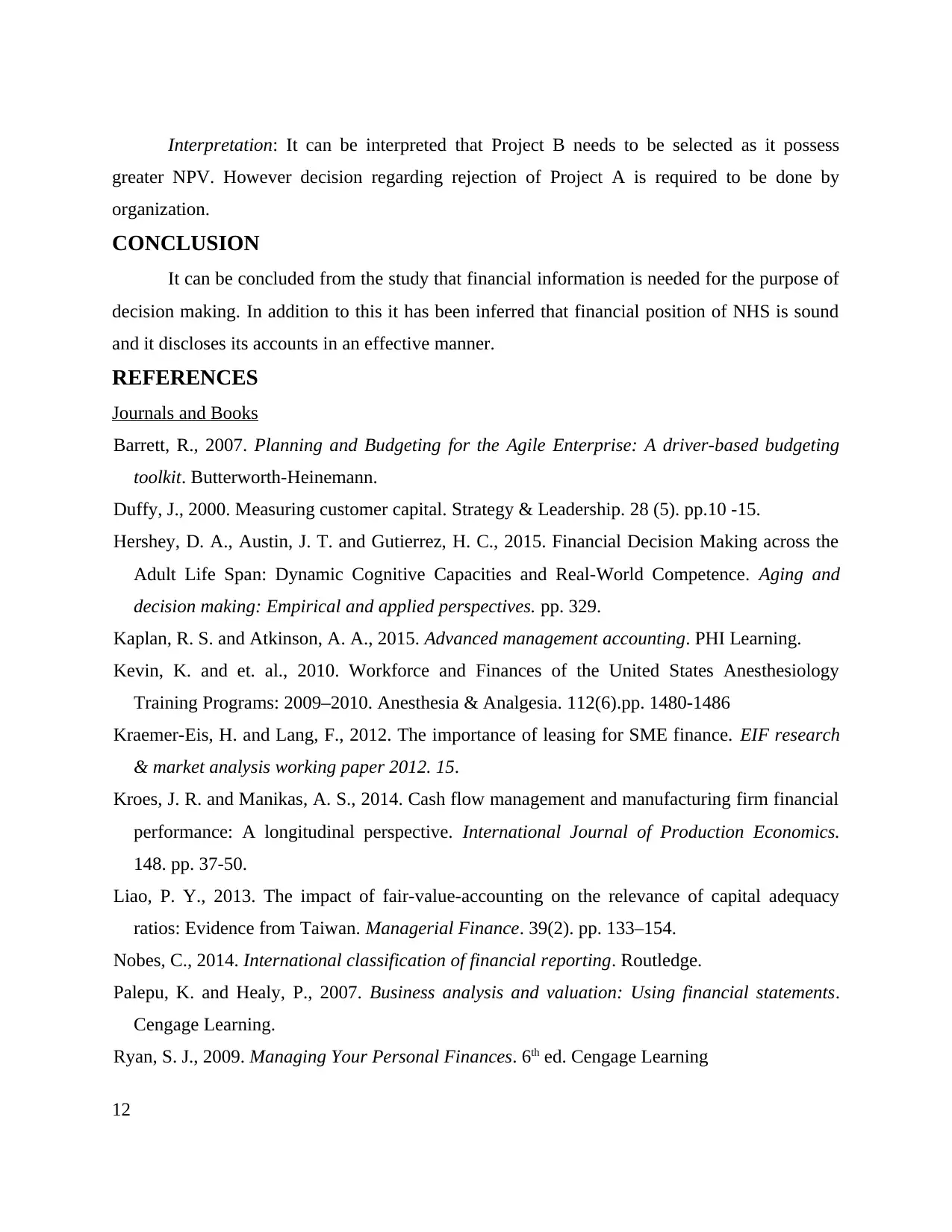
Interpretation: It can be interpreted that Project B needs to be selected as it possess
greater NPV. However decision regarding rejection of Project A is required to be done by
organization.
CONCLUSION
It can be concluded from the study that financial information is needed for the purpose of
decision making. In addition to this it has been inferred that financial position of NHS is sound
and it discloses its accounts in an effective manner.
REFERENCES
Journals and Books
Barrett, R., 2007. Planning and Budgeting for the Agile Enterprise: A driver-based budgeting
toolkit. Butterworth-Heinemann.
Duffy, J., 2000. Measuring customer capital. Strategy & Leadership. 28 (5). pp.10 -15.
Hershey, D. A., Austin, J. T. and Gutierrez, H. C., 2015. Financial Decision Making across the
Adult Life Span: Dynamic Cognitive Capacities and Real-World Competence. Aging and
decision making: Empirical and applied perspectives. pp. 329.
Kaplan, R. S. and Atkinson, A. A., 2015. Advanced management accounting. PHI Learning.
Kevin, K. and et. al., 2010. Workforce and Finances of the United States Anesthesiology
Training Programs: 2009–2010. Anesthesia & Analgesia. 112(6).pp. 1480-1486
Kraemer-Eis, H. and Lang, F., 2012. The importance of leasing for SME finance. EIF research
& market analysis working paper 2012. 15.
Kroes, J. R. and Manikas, A. S., 2014. Cash flow management and manufacturing firm financial
performance: A longitudinal perspective. International Journal of Production Economics.
148. pp. 37-50.
Liao, P. Y., 2013. The impact of fair-value-accounting on the relevance of capital adequacy
ratios: Evidence from Taiwan. Managerial Finance. 39(2). pp. 133–154.
Nobes, C., 2014. International classification of financial reporting. Routledge.
Palepu, K. and Healy, P., 2007. Business analysis and valuation: Using financial statements.
Cengage Learning.
Ryan, S. J., 2009. Managing Your Personal Finances. 6th ed. Cengage Learning
12
greater NPV. However decision regarding rejection of Project A is required to be done by
organization.
CONCLUSION
It can be concluded from the study that financial information is needed for the purpose of
decision making. In addition to this it has been inferred that financial position of NHS is sound
and it discloses its accounts in an effective manner.
REFERENCES
Journals and Books
Barrett, R., 2007. Planning and Budgeting for the Agile Enterprise: A driver-based budgeting
toolkit. Butterworth-Heinemann.
Duffy, J., 2000. Measuring customer capital. Strategy & Leadership. 28 (5). pp.10 -15.
Hershey, D. A., Austin, J. T. and Gutierrez, H. C., 2015. Financial Decision Making across the
Adult Life Span: Dynamic Cognitive Capacities and Real-World Competence. Aging and
decision making: Empirical and applied perspectives. pp. 329.
Kaplan, R. S. and Atkinson, A. A., 2015. Advanced management accounting. PHI Learning.
Kevin, K. and et. al., 2010. Workforce and Finances of the United States Anesthesiology
Training Programs: 2009–2010. Anesthesia & Analgesia. 112(6).pp. 1480-1486
Kraemer-Eis, H. and Lang, F., 2012. The importance of leasing for SME finance. EIF research
& market analysis working paper 2012. 15.
Kroes, J. R. and Manikas, A. S., 2014. Cash flow management and manufacturing firm financial
performance: A longitudinal perspective. International Journal of Production Economics.
148. pp. 37-50.
Liao, P. Y., 2013. The impact of fair-value-accounting on the relevance of capital adequacy
ratios: Evidence from Taiwan. Managerial Finance. 39(2). pp. 133–154.
Nobes, C., 2014. International classification of financial reporting. Routledge.
Palepu, K. and Healy, P., 2007. Business analysis and valuation: Using financial statements.
Cengage Learning.
Ryan, S. J., 2009. Managing Your Personal Finances. 6th ed. Cengage Learning
12
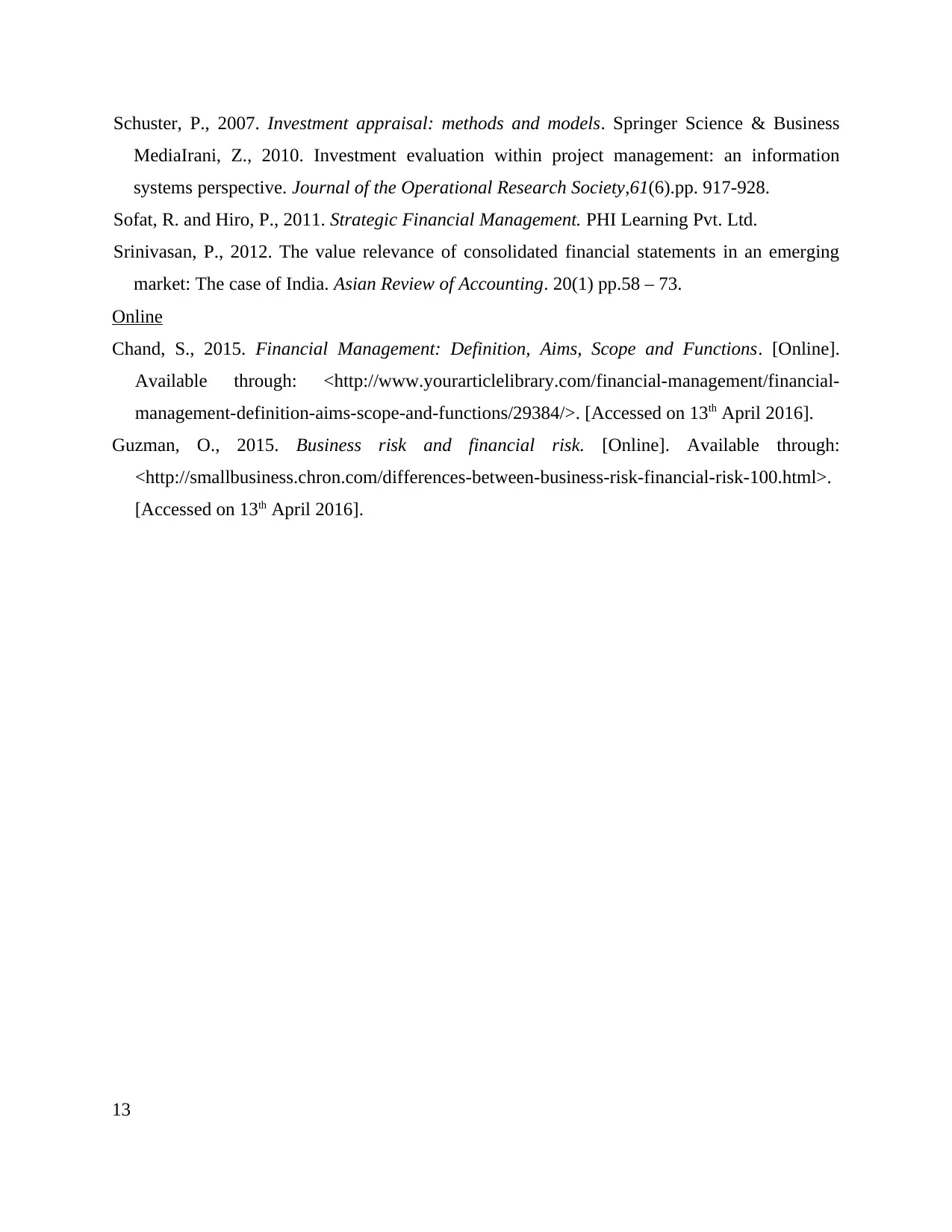
Schuster, P., 2007. Investment appraisal: methods and models. Springer Science & Business
MediaIrani, Z., 2010. Investment evaluation within project management: an information
systems perspective. Journal of the Operational Research Society,61(6).pp. 917-928.
Sofat, R. and Hiro, P., 2011. Strategic Financial Management. PHI Learning Pvt. Ltd.
Srinivasan, P., 2012. The value relevance of consolidated financial statements in an emerging
market: The case of India. Asian Review of Accounting. 20(1) pp.58 – 73.
Online
Chand, S., 2015. Financial Management: Definition, Aims, Scope and Functions. [Online].
Available through: <http://www.yourarticlelibrary.com/financial-management/financial-
management-definition-aims-scope-and-functions/29384/>. [Accessed on 13th April 2016].
Guzman, O., 2015. Business risk and financial risk. [Online]. Available through:
<http://smallbusiness.chron.com/differences-between-business-risk-financial-risk-100.html>.
[Accessed on 13th April 2016].
13
MediaIrani, Z., 2010. Investment evaluation within project management: an information
systems perspective. Journal of the Operational Research Society,61(6).pp. 917-928.
Sofat, R. and Hiro, P., 2011. Strategic Financial Management. PHI Learning Pvt. Ltd.
Srinivasan, P., 2012. The value relevance of consolidated financial statements in an emerging
market: The case of India. Asian Review of Accounting. 20(1) pp.58 – 73.
Online
Chand, S., 2015. Financial Management: Definition, Aims, Scope and Functions. [Online].
Available through: <http://www.yourarticlelibrary.com/financial-management/financial-
management-definition-aims-scope-and-functions/29384/>. [Accessed on 13th April 2016].
Guzman, O., 2015. Business risk and financial risk. [Online]. Available through:
<http://smallbusiness.chron.com/differences-between-business-risk-financial-risk-100.html>.
[Accessed on 13th April 2016].
13
1 out of 13
Related Documents
Your All-in-One AI-Powered Toolkit for Academic Success.
+13062052269
info@desklib.com
Available 24*7 on WhatsApp / Email
![[object Object]](/_next/static/media/star-bottom.7253800d.svg)
Unlock your academic potential
© 2024 | Zucol Services PVT LTD | All rights reserved.





